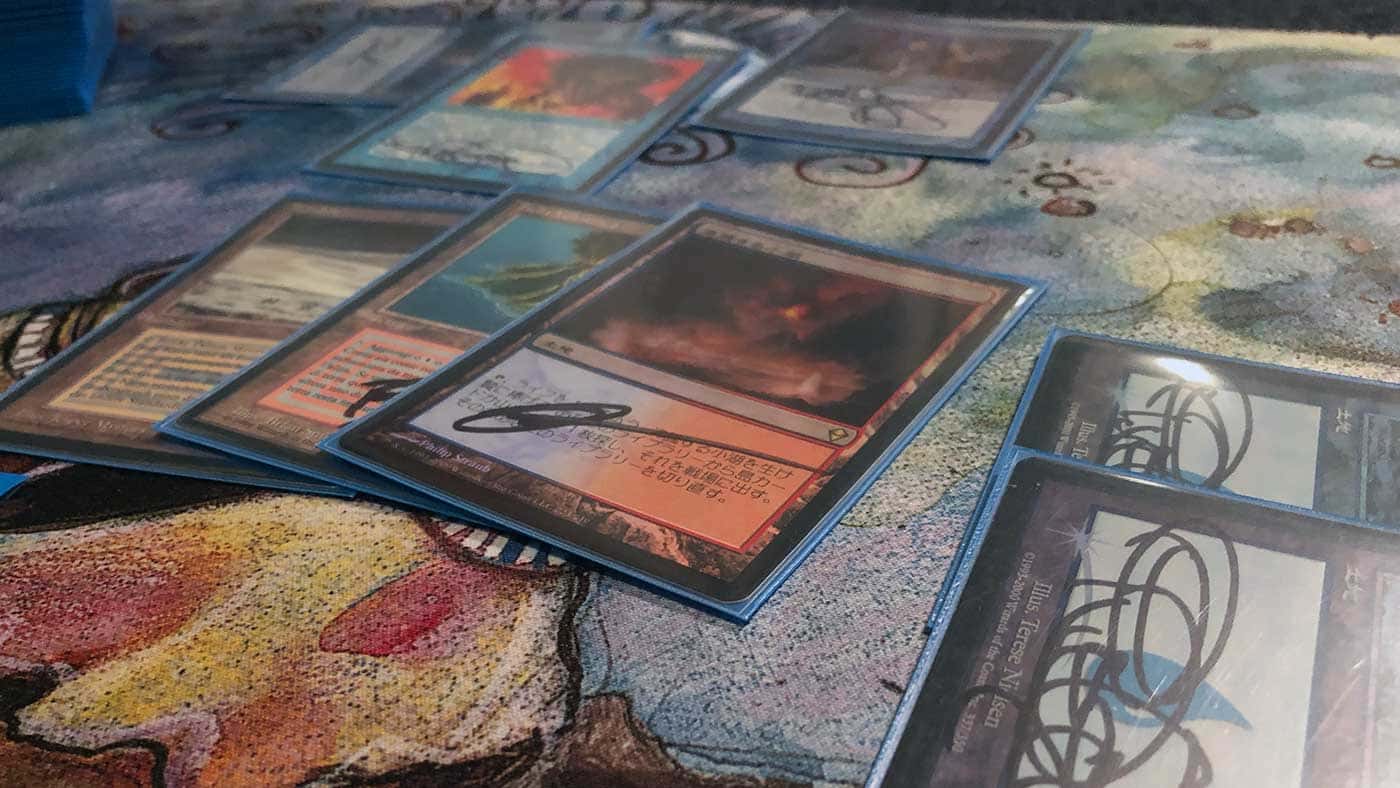Why is Miracles good?
I'm fortunate enough to have been invited to some online communities where deck discussions happen with some very bright minds. The driving force behind Miracles is several very-talented individuals (plus Anuraag) pulling together to figure out issues with the deck and how to improve it. Being a member of the storm community for years at this point, we don't work together as they do, it's something I'm envious of as I wish we had a collaboration such as theirs. That said, I've learned so much from some of them from a deck-building standpoint but also from an analytical view.
Legacy Challenge
10/07/2018
Main Deck
- 4 Brainstorm
- 4 Ponder
- 3 Preordain
- 1 Portent
- 4 Accumulated Knowledge
- 2 Predict
- 4 Flooded Strand
- 2 Scalding Tarn
- 2 Arid Mesa
- 5 Island
- 2 Plains
- 2 Tundra
- 2 Volcanic Island
Sideboard
- 1 Snapcaster Mage
- 1 Council's Judgment
- 2 Flusterstorm
- 2 Back to Basics
- 1 Celestial Purge
- 2 Engineered Explosives
- 2 Pyroblast
- 1 Red Elemental Blast
- 1 Spell Pierce
- 1 Surgical Extraction
- 1 Vendilion Clique
Here we have one of Anuraag Das's lists from a Legacy Challenge within the last month, I say "one of his lists" because Anuraag top 8'd three Legacy Challenges in the month of October. Miracles is a very good deck, but why is that? If you look at the decklist, it has some very powerful cards such as Terminus, Force of Will, Entreat the Angels, Counterbalance, Back to Basics, and Jace, the Mind Sculptor being held together by a suite of eighteen draw spells. These draw spells allow the deck to find whatever it needs in a reasonable amount of time in order to answer any given problem, but they also allow the deck to stabilize and recover from the damage the opponent may have done. Cards such as Predict and Accumulated Knowledge provided much-needed card advantage to recover from effects such as Thoughtseize or Hymn to Tourach, but more importantly, they allow the deck to pull ahead and close the door once it's gained control of the game. After a long game against Miracles, a player can be in "top-deck" mode at parity with Miracles and they're already at a disadvantage due to an Accumulated Knowledge off the top drawing three or four cards or a Snapcaster Mage doing the same. This is what has put Miracles over the top, compared to a deck like Grixis Control or Grixis Delver.
I don't believe that the second best deck in Legacy is on the same playing field at the moment and it's due to the Miracles community solving the metagame puzzle. Which brings me to my next point, how do you beat Miracles then?
If you analyze the deck, there's a lot of "air." What I mean by this is there's actually a lot of cards that simply do nothing to impact the game or board state, most of these cards are cantrips and lands (61% of their cards). The power behind Miracles, as I said, is the ability to use these card draw spells to find what they need for any given match-up, which means that their initial hands are likely cantrips, a land or two, and a random answer spell. This is the actual weakness in modern-day Miracles - their opening hands. Miracles is weakest in the set-up stages. If you can attack them at this point in the game, this is when you will be the most successful. This goes for all decks, not just combo.
If you allow Miracles to get past this stage of the game, between Predict, Accumulated Knowledge, Snapcaster Mage, and Jace, the Mind Sculptor they will bury you in card advantage and lock you out of the game even without Counterbalance. Their mid-to-late is too strong to out-grind them, this is why we've seen Grixis Control and other "grindy" decks die out slowly over the last few months.
Legacy Challenge
10/07/2018
Main Deck
- 4 Brainstorm
- 4 Ponder
- 3 Preordain
- 1 Portent
- 4 Accumulated Knowledge
- 2 Predict
- 4 Flooded Strand
- 2 Scalding Tarn
- 2 Arid Mesa
- 5 Island
- 2 Plains
- 2 Tundra
- 2 Volcanic Island
Sideboard
- 1 Snapcaster Mage
- 1 Council's Judgment
- 2 Flusterstorm
- 2 Back to Basics
- 1 Celestial Purge
- 2 Engineered Explosives
- 2 Pyroblast
- 1 Red Elemental Blast
- 1 Spell Pierce
- 1 Surgical Extraction
- 1 Vendilion Clique
Main Deck
- 4 Brainstorm
- 4 Ponder
- 3 Preordain
- 1 Portent
- 4 Accumulated Knowledge
- 2 Predict
- 4 Flooded Strand
- 2 Scalding Tarn
- 2 Arid Mesa
- 5 Island
- 2 Plains
- 2 Tundra
- 2 Volcanic Island
Sideboard
- 1 Snapcaster Mage
- 1 Council's Judgment
- 2 Flusterstorm
- 2 Back to Basics
- 1 Celestial Purge
- 2 Engineered Explosives
- 2 Pyroblast
- 1 Red Elemental Blast
- 1 Spell Pierce
- 1 Surgical Extraction
- 1 Vendilion Clique
Here we have one of Anuraag Das's lists from a Legacy Challenge within the last month, I say "one of his lists" because Anuraag top 8'd three Legacy Challenges in the month of October. Miracles is a very good deck, but why is that? If you look at the decklist, it has some very powerful cards such as Terminus, Force of Will, Entreat the Angels, Counterbalance, Back to Basics, and Jace, the Mind Sculptor being held together by a suite of eighteen draw spells. These draw spells allow the deck to find whatever it needs in a reasonable amount of time in order to answer any given problem, but they also allow the deck to stabilize and recover from the damage the opponent may have done. Cards such as Predict and Accumulated Knowledge provided much-needed card advantage to recover from effects such as Thoughtseize or Hymn to Tourach, but more importantly, they allow the deck to pull ahead and close the door once it's gained control of the game. After a long game against Miracles, a player can be in "top-deck" mode at parity with Miracles and they're already at a disadvantage due to an Accumulated Knowledge off the top drawing three or four cards or a Snapcaster Mage doing the same. This is what has put Miracles over the top, compared to a deck like Grixis Control or Grixis Delver.
I don't believe that the second best deck in Legacy is on the same playing field at the moment and it's due to the Miracles community solving the metagame puzzle. Which brings me to my next point, how do you beat Miracles then?
If you analyze the deck, there's a lot of "air." What I mean by this is there's actually a lot of cards that simply do nothing to impact the game or board state, most of these cards are cantrips and lands (61% of their cards). The power behind Miracles, as I said, is the ability to use these card draw spells to find what they need for any given match-up, which means that their initial hands are likely cantrips, a land or two, and a random answer spell. This is the actual weakness in modern-day Miracles - their opening hands. Miracles is weakest in the set-up stages. If you can attack them at this point in the game, this is when you will be the most successful. This goes for all decks, not just combo.
If you allow Miracles to get past this stage of the game, between Predict, Accumulated Knowledge, Snapcaster Mage, and Jace, the Mind Sculptor they will bury you in card advantage and lock you out of the game even without Counterbalance. Their mid-to-late is too strong to out-grind them, this is why we've seen Grixis Control and other "grindy" decks die out slowly over the last few months.



















